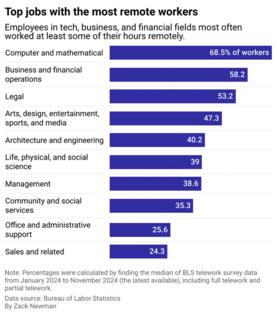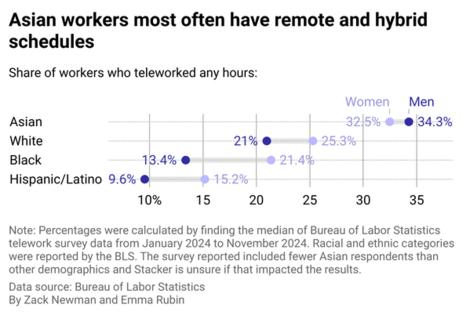Who got to work remotely in 2024 and who didn't, according to data
Published in Slideshow World
Subscribe
Who got to work remotely in 2024 and who didn't, according to data
Remote work has transformed how millions of Americans approach their jobs. While many workplaces adopted telework out of necessity due to the COVID-19 pandemic, the trend has evolved from a rare exception to common practice. It's impacted everything from public transportation patterns to housing markets to such a degree that some have called it a "revolution."
Between 2019 and 2021, the rate of people working remotely tripled to 17.9% of the workforce, according to the Census Bureau. By the end of 2024, roughly 1 in 5 American workers were still signing in from home, with 1 in 10 working remotely full-time, according to a Stacker analysis of federal survey data.
Most of these workers are happy with the situation. A 2023 Pew Research Center survey found that 71% of people who log in from home said it helped balance work and personal life, while 56% said it improved their productivity. A third of respondents working from home most or some of the time said they'd like to be fully remote. Pew's research also found that certain groups, like parents of children under 18, were more likely than others to work from home, citing work-life balance as one of the perks.
But not everyone has equal access to these benefits. To better understand who's working remotely,accessiBe analyzed data from the Bureau of Labor Statistics to determine how access to a remote schedule varies by a worker's ability, job type, and demographics.
Visit thestacker.com for similar lists and stories.
Which industries lend themselves more to remote work?
While the overall rate of remote work has increased, not all industries offer the same opportunities for employees.
White-collar roles have the highest rates of people signing in from home. BLS data shows that more than half of employees in tech, business, and legal professions telecommute, with workers in computer- and math-related fields leading the way at a rate of 68.5%. Managers have also embraced remote work, with nearly 40% leading their teams from home at least some of the time.
By contrast, some jobs are less likely to be done remotely. During the pandemic, the Centers for Disease Control classified food service workers as "essential" and hailed them as heroes because they had to physically go to their places of work. Today, this category of workers has the lowest rate of remote work, at just 1.4%. Transportation and construction follow, with only 2% and 2.7% of workers, respectively, able to telework.
Other fields fall somewhere in the middle. Educators, for example, experienced significant changes during the pandemic. In the spring of 2020, 77% of public schools had transitioned to online learning, and 84% of college students reported at least some virtual instruction, according to theNational Center for Education Statistics. While those numbers have since declined, 15% of educators and library workers still worked remotely in 2024, according to BLS.
Even health care—an industry known for hands-on work—has adapted. Today, 13.5% of health care professionals perform their duties remotely, often through telehealth or by handling administrative tasks from home. Working remotely can help address burnout, which was reported by nearly half of health care workers in 2022, according to the CDC.
Who could telecommute and why they might prefer it that way?
Editor's note: BLS survey respondents were limited to binary gender classifications, excluding those identifying as nonbinary. We also recognize that Hispanic and Latino are not interchangeable terms. The usage of Hispanic and Latino in this story is based on the language used by the BLS.
Teleworking rates vary significantly depending on a worker's gender or racial and ethnic background. BLS data shows that Asian workers are typically most likely to telework, with 34.3% of Asian men and 32.5% of Asian women saying they worked remotely some or all of the time. Hispanic or Latino workers had the lowest rates, with 15.2% of women and only 9.6% of men doing the same.
It's important to note that people identifying as Asian made up the smallest surveyed group, with nearly 11 million respondents compared to 120 million identifying as white, 30 million as Hispanic or Latino, and 20 million as Black. Asian workers were also unique in that men were more likely to telework than women. Among white and Black workers, women were more likely than men to work remotely.
Remote work can have a unique appeal for employees who experience workplace discrimination. As far back as 2021, Black "knowledge workers" were more enthusiastic about working from home than their white colleagues, according to a survey from Future Forum. Their research found that one reason for this preference was that remote work reduces the need for code-switching and creates fewer opportunities for bias.
"I'm Black. Remote work has been great for my mental health," writer and network engineer LeRon Barton wrote for Slate in 2022. "How many racist scenarios, comments and situations would I have avoided enduring if I didn't need to come into the office?"
Employees with disabilities report record workforce participation
Among workers with disabilities, 37.4% were employed in management and professional jobs in areas such as business, finance, law, and education, according to the 2023 Bureau of Labor Statistics data. Service occupations followed next with 19.4% of workers with disabilities performing work in industries such as health care, food preparation, and building support. For individuals with impairments that affect mobility, vision, hearing, or other daily functions, remote work can be more than a convenience in any industry—it's a lifeline for meaningful employment.
Of BLS survey respondentswho reported having a disability, 25% said they typically worked from home in some capacity in 2024, slightly higher than the 23% of respondents who said they didn't have disabilities.
"It is no coincidence that the rise of remote work has coincided with the highest employment rates for disabled individuals in 15 years,"Economic Innovation Group analysts noted in 2023. Their research showed that remote schedules eliminate the daily commutes and office environments that can present significant barriers for employees with disabilities. Working from home also allows employees with disabilities to take breaks as needed or use assistive technology at home that is not accessible in a traditional workplace.
As the remote work revolution evolves, it's critical that employers address existing disparities by ensuring accessibility for all employees regardless of where they're working. This offers a more effective work environment and an inclusive and productive future for all workers.
Story editing by Carren Jao. Additional editing by Elisa Huang. Copy editing by Kristen Wegrzyn.
This story originally appeared on accessiBe and was produced and distributed in partnership with Stacker Studio.










Comments